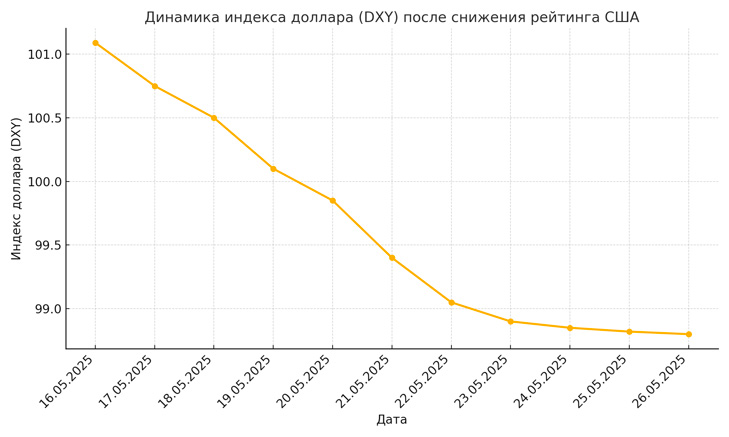How the markets reacted to reduce the US credit rating
On May 16, 2025, the Moody's rating agency lowered the US credit rating from the highest AAA level to AA1.

This decision became the next alarming signal for financial markets after similar Fitch actions in 2023 and Standard & Poor's in 2011.
Thus, for the first time in the last hundred years, the largest economy of the world simultaneously lost the highest assessment of all three leading rating agencies.
The main reasons for such a decision were the growing budget deficits, the high cost of servicing public debt and the lack of clear steps by the American government to stabilize financial policy.
The market reaction to this event was instant, but moderate in comparison with historical experience. In the first days after the announcement, the profitability of 30-year-old treasury bonds of the United States increased sharply, exceeding 5% for the first time since 2023. But the number of people who want to buy them has practically decreased to zero.
The American dollar during this period lost about 2.3%, demonstrating the caution of investors who prefer to reduce risks.

Against the backdrop of a reduction in the rating, investors massively transfer funds from the dollar into more protected assets.
Gold , which is a traditional protective asset, reacted 7% growth over the past time, which confirms the intensified expectations of further instability.
The stock markets reacted ambiguously:
- S&P 500: decreased from 5 958.38 to 5,802.82 points, having lost 155.56 points or -2.61%.
- NASDAQ Composite: fell from 19,211.10 to 18,737.21 points, the decrease was 473.89 points or -2.47%.
- Dow Jones Industrial Average: It decreased from 42,654.74 to 41,603.07 points, losing 1,051.67 points or -2.47%.
The shares of large financial companies, especially banks and insurers, experienced short -term pressure, but quickly stabilized against the backdrop of moderate statements of the federal reserve system.
In order to better understand what prospects are now opening before the markets, it is worth turning to the historical experience of a similar decline in August 2011, when the Standard & Poor's agency first reduced the US rating to AA+.

Then the market reaction was much more sharp: the Dow Jones index in one trading day fell by 5.5%, which became the largest day fall from the 2008 crisis.
Gold at that time set a historical record, and the US treasury bonds, contrary to expectations, also attracted significant volume of capital, emphasizing the paradoxical attractiveness of these instruments even when the rating is reduced.
Today's situation differs from the events of 2011 in that now the markets perceive the reduction of the rating more calmly, although no less seriously.
The alertness of investors is explained, first of all, by deep concern about the fiscal future of the United States.
The public debt has already approached $ 36 trillion, and the budget deficit continues to steadily increase, which in the next decade is able to aggravate the situation even more.

In the near future, the following factors will affect the behavior of investors:
- Capital redistribution into safer assets, such as gold, silver and government bonds of countries with a stable economy (Norway, Switzerland, Singapore).
- The weakening of the US dollar in relation to the races: Japanese yen and the Swiss franc.
- The likelihood of increasing the demand for cryptocurrencies, such as Bitcoin, which may be an alternative to traditional financial instruments in conditions of increased uncertainty.
Thus, a decrease in the US credit rating is an important signal that indicates the need for careful monitoring of macroeconomic indicators and the policy of central banks.
Despite the relative calm in the short term, the long -term consequences of such a step can have a deeper effect on the markets and significantly adjust investment strategies around the world.
